Aamjiwnaang First Nation is asking the Ontario government to work together to improve environmental conditions in the community.
A delegation of First Nation members, including Chief Janelle Nahmabin, was in Toronto for a rally at Queen's Park on Thursday morning.
Multiple speakers voiced their concerns about the ongoing state of emergency, declared in April, and the impacts of pollution on the community as a whole.
While high levels of benzene emissions prompted the recent emergency, the First Nation said there are other harmful pollutants present.
"The environmental injustice that the people of Aamjiwnaang have been subject to is an ongoing tragedy and is a stark example of environmental racism," said Band Councillor Darren Henry.
Aamjiwnaang First Nation is located near oil refineries, petrochemical and chemical facilities in Sarnia, often referred to as Chemical Valley.
Chief Nahmabin said they are not calling for the closure of every plant and facility in and around the First Nation.
"What we're saying is that there is technology available that would make it safer for our community, and for the people who work within these facilities," said Nahmabin. "We are just wanting to help create a better tomorrow -- a better future, and we're looking for collaboration in this. We are not out to put fear in people's hearts for the reliability of their employment but to protect them as well and to protect our members of Aamjiwnaang First Nation and surrounding communities."
Nahmabin said they're asking for regulations surrounding Sulphur dioxide levels (SO2) to be updated.
"Pollution control solutions are readily available and they are cost-effective," said Nahmabin. "We have recommendations that would lower SO2 levels, such as updating and implementing [Lambton Industry Meteorological Alert]. This is the first step in addressing the cumulative impacts on our community. There's no longer any excuse for Ontario government officials to continue to delay implementing these solutions."
Currently, alerts are triggered when the 24-hour running average SO2 concentration at any monitoring station in the LIMA System reaches 0.07 parts per million parts of air.
The Ontario government is also being called to conduct necessary technical reviews, complete comprehensive follow-up investigations to assess impacts of past contamination, and to review the need for improved oversight of industry process safety management practices.
The delegation said the Crown should also work with Aamjiwnaang to follow up on recommendations from past health studies and continue to monitor diseases, such as cancer.
"Aamjiwnaang will no longer be known as the community that's victims of Chemical Valley, but we will be known for our environmental leadership," said Nahmabin.
Aamjiwnaang First Nation Environment Coordinator Lynn Rosales also referenced Bill C226, an act respecting the development of a national strategy to assess, prevent and address environmental racism and to advance environmental justice. The federal bill received royal assent on June 20.
Rosales specifically pointed out the bill's content, to examine "the link between race, socio-economic status and environmental risk" and measures that can be taken.
"As we look toward tomorrow and recognize that we are the conduit from our past to our future, it's time to put aside our differences and work collectively to ensure that there will be clean water to drink, fresh air to breathe, and good land for sustainable living for all of humanity," Rosales said. "Most of all, we need to ensure that there is a future for the next seven generations."
A media release said representatives from the community are expected to visit Korea later this month for INC5, the UN global plastics treaty negotiations.
- With files from Stephanie Chaves






